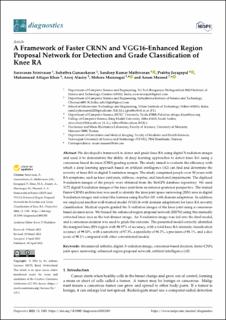| dc.contributor.author | Srinivasan, Saravanan | |
| dc.contributor.author | Gunasekaran, Subathra | |
| dc.contributor.author | Mathivanan, Sandeep Kumar | |
| dc.contributor.author | Jayagopal, Prabhu | |
| dc.contributor.author | Khan, Muhammad Attique | |
| dc.contributor.author | Alasiry, Areej | |
| dc.contributor.author | Marzougui, Mehrez | |
| dc.contributor.author | Masood, Anum | |
| dc.date.accessioned | 2023-11-17T15:35:59Z | |
| dc.date.available | 2023-11-17T15:35:59Z | |
| dc.date.created | 2023-05-22T13:17:19Z | |
| dc.date.issued | 2023 | |
| dc.identifier.citation | Diagnostics (Basel). 2023, 13 (8), . | en_US |
| dc.identifier.issn | 2075-4418 | |
| dc.identifier.uri | https://hdl.handle.net/11250/3103325 | |
| dc.description.abstract | We developed a framework to detect and grade knee RA using digital X-radiation images and used it to demonstrate the ability of deep learning approaches to detect knee RA using a consensus-based decision (CBD) grading system. The study aimed to evaluate the efficiency with which a deep learning approach based on artificial intelligence (AI) can find and determine the severity of knee RA in digital X-radiation images. The study comprised people over 50 years with RA symptoms, such as knee joint pain, stiffness, crepitus, and functional impairments. The digitized X-radiation images of the people were obtained from the BioGPS database repository. We used 3172 digital X-radiation images of the knee joint from an anterior–posterior perspective. The trained Faster-CRNN architecture was used to identify the knee joint space narrowing (JSN) area in digital X-radiation images and extract the features using ResNet-101 with domain adaptation. In addition, we employed another well-trained model (VGG16 with domain adaptation) for knee RA severity classification. Medical experts graded the X-radiation images of the knee joint using a consensus-based decision score. We trained the enhanced-region proposal network (ERPN) using this manually extracted knee area as the test dataset image. An X-radiation image was fed into the final model, and a consensus decision was used to grade the outcome. The presented model correctly identified the marginal knee JSN region with 98.97% of accuracy, with a total knee RA intensity classification accuracy of 99.10%, with a sensitivity of 97.3%, a specificity of 98.2%, a precision of 98.1%, and a dice score of 90.1% compared with other conventional models. | en_US |
| dc.language.iso | eng | en_US |
| dc.publisher | MDPI | en_US |
| dc.rights | Navngivelse 4.0 Internasjonal | * |
| dc.rights.uri | http://creativecommons.org/licenses/by/4.0/deed.no | * |
| dc.title | A Framework of Faster CRNN and VGG16-Enhanced Region Proposal Network for Detection and Grade Classification of Knee RA | en_US |
| dc.title.alternative | A Framework of Faster CRNN and VGG16-Enhanced Region Proposal Network for Detection and Grade Classification of Knee RA | en_US |
| dc.type | Peer reviewed | en_US |
| dc.type | Journal article | en_US |
| dc.description.version | publishedVersion | en_US |
| dc.source.pagenumber | 0 | en_US |
| dc.source.volume | 13 | en_US |
| dc.source.journal | Diagnostics (Basel) | en_US |
| dc.source.issue | 8 | en_US |
| dc.identifier.doi | 10.3390/diagnostics13081385 | |
| dc.identifier.cristin | 2148485 | |
| cristin.ispublished | true | |
| cristin.fulltext | original | |
| cristin.qualitycode | 1 | |

